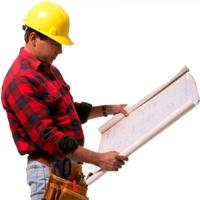A Garden Office and its Domestic Carbon Footprint
by Guest Post on Jun 16, 2010
How can we conserve energy at home and in our garden offices and other domestic buildings?
There has been much talk about renewable energy and new technologies such as ground source heat pumps and grey water recycling for use around the home. Most new domestic technologies are still in the development stage and have twenty or thirty-year pay-back periods.
A wind turbine in the garden would suffer from limited wind speed in urban areas, needs planning permission, and unless 2 or 3 meters in span produce very little electricity. However, if you live on the top of a windy hill a wind turbine is a good idea. Solar panels for generating hot water are worth considering and are cost-effective in your house rather than in your garden office.
The investment in new technologies is definitely worthwhile personally and globally if you are building a new house or if you intend to live in your home for life. But there are simple measures that all of us can take in our homes and our garden offices to help reduce our carbon footprint.
So what are the simplest and fastest ways of reducing energy consumption in a new garden office, granny flat, and in our homes?
Here’s an energy checklist below: -
- High levels of insulation. Is your loft insulated? Have you got cavity wall insulation in the house? Have you got building regulation levels of insulation in your garden office to help balance your carbon footprint?
- In a larger garden office, you could heat with a wood-burning stove. Woodburners burn efficiently and the resulting ash can be composted or spread straight onto your garden.
- Double glazing. Have all the rooms in your house, including your garden office, got double glazing?
- When choosing new domestic appliances and garden office equipment ask for an energy rating. Don't leave any electrical equipment on standby. [Plasma TVs use more electricity than traditional televisions.]
- Building materials. Have the building materials in your new extension, loft conversion, or garden office been manufactured in the UK to reduce carbon miles, and do the manufacturers care about their carbon footprint? Do they recycle, and how do they fuel their manufacturing plant?
- Small but effective measures are energy-saving light bulbs. Washing your clothes at 30 degrees. Walking!
Many garden office suppliers are building offices using SIPS panels which are made from a thin layer of plastic insulation sandwiched between two sheets of OSB. This means that air cannot circulate and condensation and mold will form unless you use air-conditioning as we all know, air conditioning is costly to the pocket as well as the environment.
There are no Government insulation or building standards for smaller garden offices. This means that badly constructed and inadequately insulated buildings are being supplied as garden offices.
With the world’s increasing concern about climate change, many garden offices are built to consume less energy and reduce their contribution to global warming. For example, walls that are 200mm thick, ceilings 310mm thick, and floors 255mm thick. All are filled with double layers of insulation and designed and checked with government approved software to ensure that condensation cannot form within the building or the walls.
Over 25% of the UK’s CO2 emissions come from inadequate insulation in domestic buildings. To further cut down on CO2 emissions, eco-friendly insulation can be put into a garden office. These eco-friendly materials have been manufactured using as little energy and chemicals, and as much recycling, as possible.
Popular Articles
Three Places to Spend Money on the Exterior of Your Home
When you have the exterior of your home remodeled, you are investing, time, energy and convenience into the project and you want to make sure that...
105132 Views
Homemade Headboards-Make an Upholstered or Wooden Headboard
Homemade headboards can add a lot of personality to any bedroom. They can be coordinated with existing furniture and room decor or they can be the...
80249 Views
When to Use a Brush, Roller or Sponge Brush
Brushes are a good choice for painting trim and woodwork. They are also useful for cutting in the edges around the top and bottom edges and corners...
72892 Views
Creating a Cottage Kitchen with Bead Board
Kitchen decor can range from modern and bold to elegant and elaborate by using strategic kitchen pieces. One of the most popular decorating trends...
58663 Views
Gas Fireplace Diagnostics and Troubleshooting
Follow these steps for diagnosing and troubleshooting Gas Fireplaces repairs. For the average DIYer, this may seem intimidating, depending on the...
35686 Views
Latest Articles
Why Professional Boiler Repair is Essential for Home Safety and Comfort
Maintaining a warm and safe home environment is paramount for any homeowner. Your home's boiler system plays a critical role in this, but what...
on Nov 5, 2025
How to Keep Your Home Warm in the Winter
How to Keep Your Home Warm in the WinterAs winter approaches, keeping your home warm becomes a priority for comfort and health. Efficient heating...
on Oct 29, 2025
Why Reliable Furnace Repair is Essential for Winter Comfort
As the cold season approaches, homeowners recognize the critical role that a well-functioning furnace plays in ensuring a warm and cozy living...
on Oct 29, 2025
How Much Does it Cost to Take a Bath?
Plumbers know that a bath may seem like a relaxing luxury, but the real cost extends far beyond your water bill. The average soak uses 35 to 50...
on Apr 8, 2025
10 Concrete Patio Ideas on a Budget
A concrete patio can be a game-changer for your outdoor space. It is durable, versatile, and can be customized to fit your style. But what if you...
on Mar 25, 2025
Featured Articles
What Type of Licensed Contractor Should You Hire?
on Feb 28, 2017
Hire Contractors / Estimates

Looking for a specialty project? There are many types of contractors available for your home improvement needs. Finding the right type of...
Actions
Top Categories
- Garden / Landscaping / Patio — 264
- Kitchen / Bathrooms — 240
- Real Estate / Finance — 203
- Appliance / Repair — 186
- Interior Design / Decor — 184
- HVAC / Air Conditioning — 150
- Cleaning / Maintenance — 144
- Improvements / Remodeling — 131
- Plumbing / Basements — 118
- Floors / Tile / Hardwood — 116
- Safety / Security — 114
- Doors / Garages — 113
Articles Archive
More DIY Articles
How to Pull Off a Luxury Room Design on a Budget
You don’t have to be a millionaire to feel like one. There are many ways that you can decorate your home to have that million dollar look without...
When Would You Need to Hire a Locksmith?
Without knowing it, it is actually the small things that may sometimes hurt us the most. Take, for instance, those locks, which are not functioning...
Can I Clean My Home’s Air Ducts Myself?
As a DIYer, we love to save money and do things just like the pros do. So what about HVAC systems? Is it possible to clean your own air ducts,...
12 Top Tips for Tiling a Bathroom
Want to save some pennies work on some home improvement projects yourself, such as renovating your bathroom? It’s well worth thinking about taking...
Improve the Value of Your Home with Beautiful Quality Blinds
Homeowners are always looking for new ways to improve the overall value of their home. One of the easiest and most economical things that you can...

